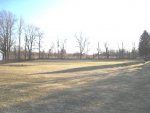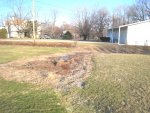I need to get some drain pipe into certain areas of my yard that I can barely mow even when it hasn't rained in a while. I've been checking into one of those walk behind trenchers. I'd like to rent it now, thinking that it won't sink into the bad areas because of the frost still in the ground (although there's a bit of water on those areas now). The rental place said to wait a couple weeks. Does anyone have experience with using these things on ground at the end of winter? The one area is pretty much like a swamp and it just seems it would make more sense to do the work now, provided the teeth can trench into the ground....
Also, I realize that the deeper I put the pipe, the more area it will drain, but I need to stub the end out somewhere, right? How deep is the pipe usually put in the ground? I'm guessing that is based on where the low end will be? So it is exposed and will drain? I'm running it towards a ditch that winds up in a creek, but there's no way to get machinery into that ditch because of shrubs on one side and a steep banck on the other, even if I rented a mini excavator. I'll try to get up a couple pics later.
Any help would be appreciated. Thanks.
Also, I realize that the deeper I put the pipe, the more area it will drain, but I need to stub the end out somewhere, right? How deep is the pipe usually put in the ground? I'm guessing that is based on where the low end will be? So it is exposed and will drain? I'm running it towards a ditch that winds up in a creek, but there's no way to get machinery into that ditch because of shrubs on one side and a steep banck on the other, even if I rented a mini excavator. I'll try to get up a couple pics later.
Any help would be appreciated. Thanks.




